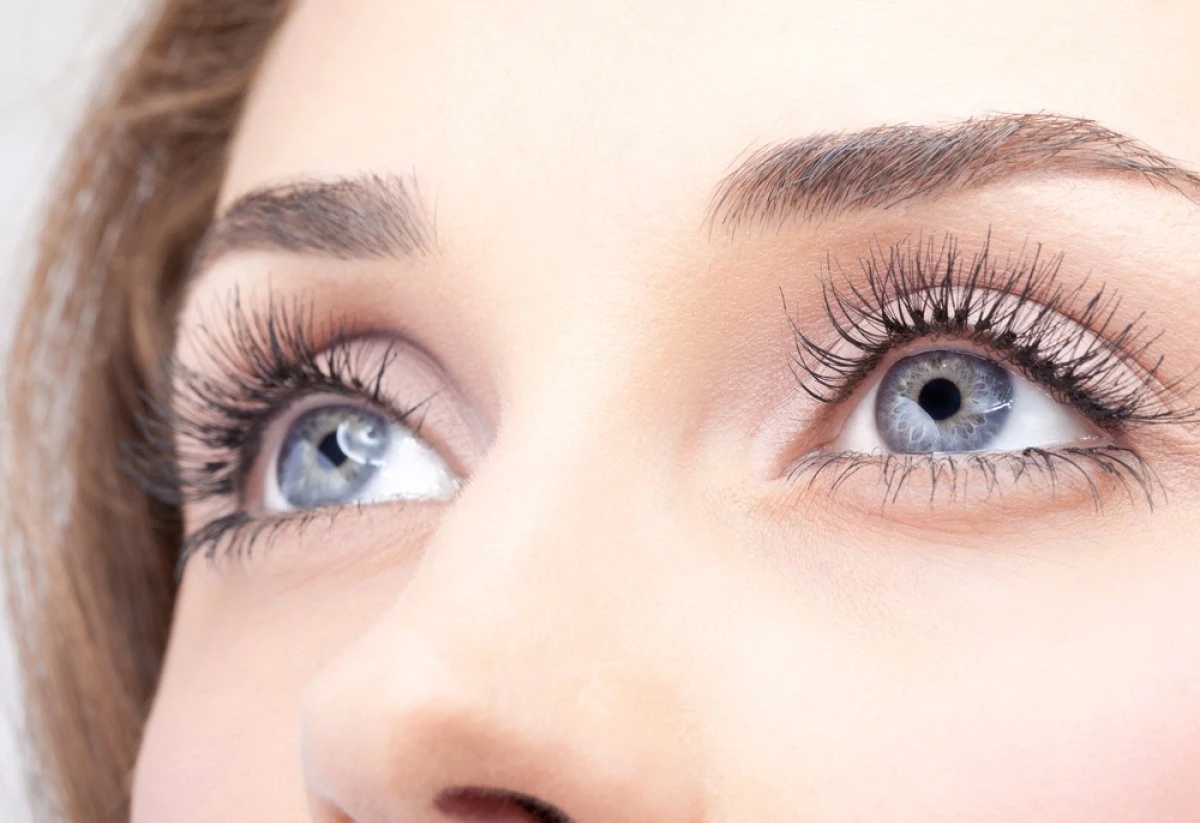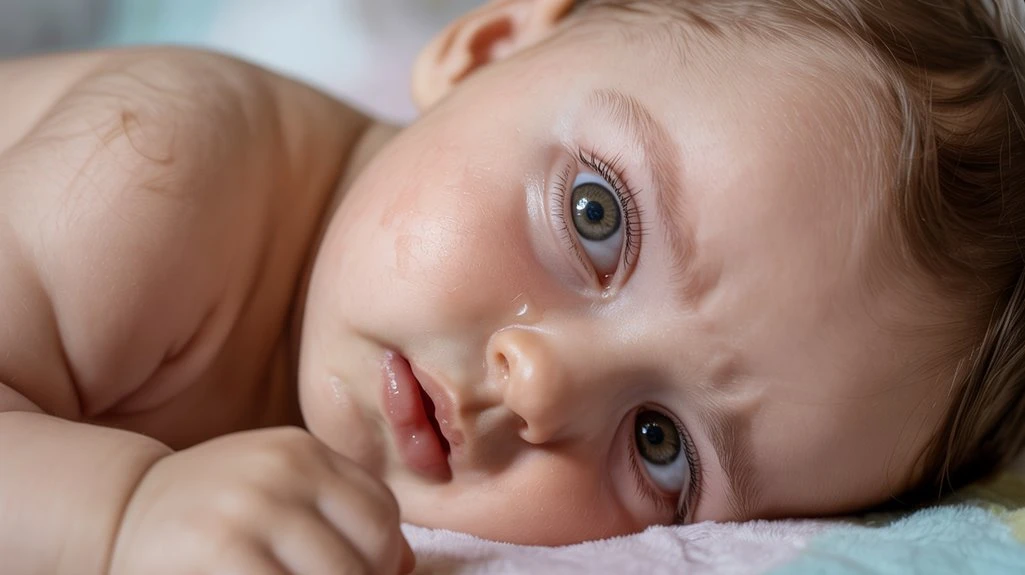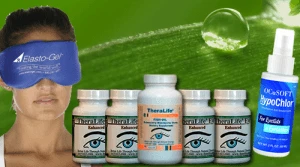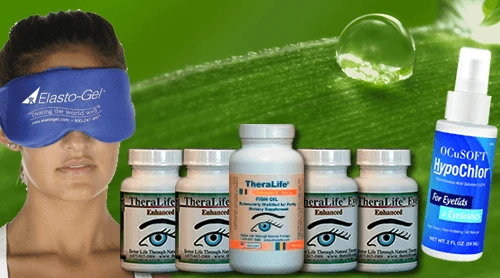If your baby has watery eye, it is often due to blocked tear ducts, common in newborns, leading to tear overflow. Other causes may include mild infections like conjunctivitis, allergies to dust or pollen, or exposure to irritants such as smoke. You might also notice sticky discharge or redness. While these issues typically resolve over time, certain symptoms may require prompt evaluation.
At TheraLife, we offer unique oral eye treatment care to support your baby’s eye health. Our products are designed to provide comprehensive relief and are the only oral solutions available for eye-related issues. With TheraLife, you can trust that you are giving your baby the best care possible, ensuring their comfort and well-being. Explore further to understand how TheraLife’s products can benefit your baby and when to seek medical help.
Powerful Oral Treatment For Watery Eyes- TheraLife
Add To Cart
Key Takeaways
- Blocked or narrow tear ducts are a common cause of excessive tearing in newborns.
- Allergies or environmental irritants like pollen and dust can trigger watery eyes in babies.
- Viral or bacterial eye infections may lead to increased tearing and abnormal eye discharge.
- Sudden changes in temperature or exposure to wind can stimulate extra tear production.
- Persistent watery eyes with redness or thick discharge may indicate a condition needing medical evaluation.
Common Reasons for Excessive Tearing in Infants
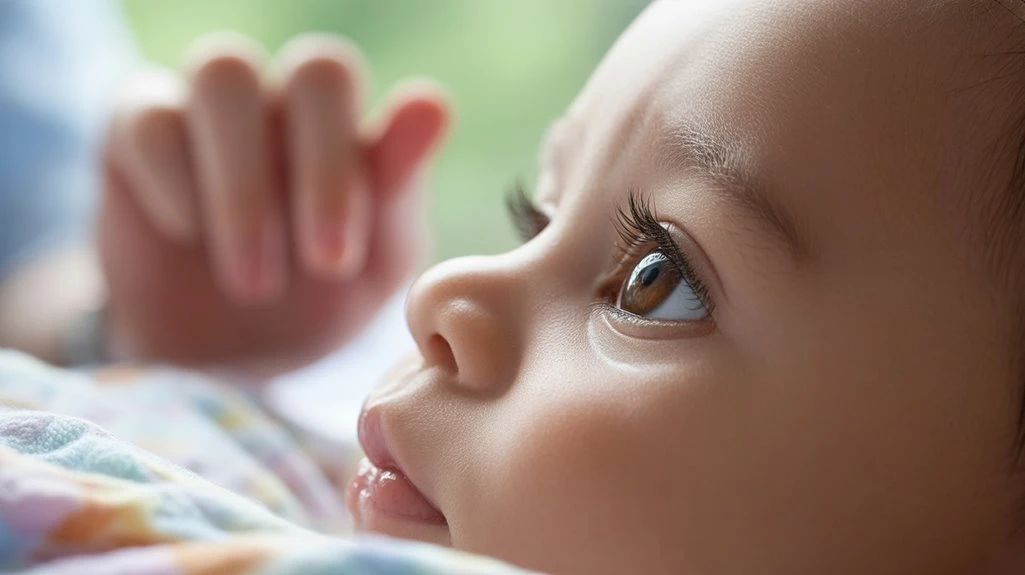
Although it can be concerning to notice your baby’s eyes watering more than usual, excessive tearing is often linked to several common causes.
In infants, the tear duct anatomy isn’t fully developed at birth, making blocked or narrow tear ducts a frequent issue. Allergies, viral conjunctivitis, or exposure to irritants like smoke can also lead to watery eyes. Additionally, changes in temperature or wind may stimulate increased tear production as a protective response. Blocked tear ducts affect approximately 10% of newborns, leading to constant watery eyes and potentially yellow or white discharge.
Practicing proper infant eye care—such as gently cleaning your baby’s eyes and minimizing exposure to potential irritants—can help reduce symptoms.
Understanding these common causes helps you take appropriate steps and monitor your child’s symptoms, ensuring prompt attention if issues persist or worsen over time.
Signs of a Blocked Tear Duct
When a tear duct is blocked in your baby, you’ll often notice persistent tearing that doesn’t resolve on its own.
Blocked duct symptoms stem from the tear duct anatomy—tears can’t drain properly, so they collect in the eye or spill onto the cheek.
As you observe your baby, pay close attention to these key signs:
- Constant watery eyes – Tears seem to overflow even when your baby isn’t crying.
- Mucus buildup – A sticky, sometimes yellow discharge accumulates at the corner of the eye.
- Mild redness – The skin around the eye may look slightly irritated from frequent wiping.
- Crusting on eyelids – You might find dried mucus or crusting, especially after naps.
Recognizing these early signs helps you seek timely medical advice. It’s important to maintain good eyelid hygiene to prevent any potential irritation or infection from developing.
Infections and Their Role in Watery Eyes
Since a baby’s eyes are especially sensitive, infections can quickly lead to increased tearing and discharge. Two common culprits are viral conjunctivitis and bacterial infections. Viral conjunctivitis, often called “pink eye,” typically causes watery eyes, redness, and mild irritation. Bacterial infections, on the other hand, may result in thicker, yellow or green discharge, crusting on the eyelids, and more pronounced redness. Styes, caused by Staphylococcus aureus bacteria, can also contribute to watery eyes and require prompt attention. Prompt recognition and treatment are essential to prevent complications. Here’s a quick comparison:
| Infection Type | Common Symptoms |
|---|---|
| Viral conjunctivitis | Watery discharge, mild redness |
| Bacterial infections | Thick discharge, eyelid crusting |
| Both | Increased tearing, eye irritation |
If your baby’s eye becomes red, swollen, or produces unusual discharge, contact your pediatrician. Early management helps protect your baby’s vision and comfort.
Allergies and Environmental Triggers
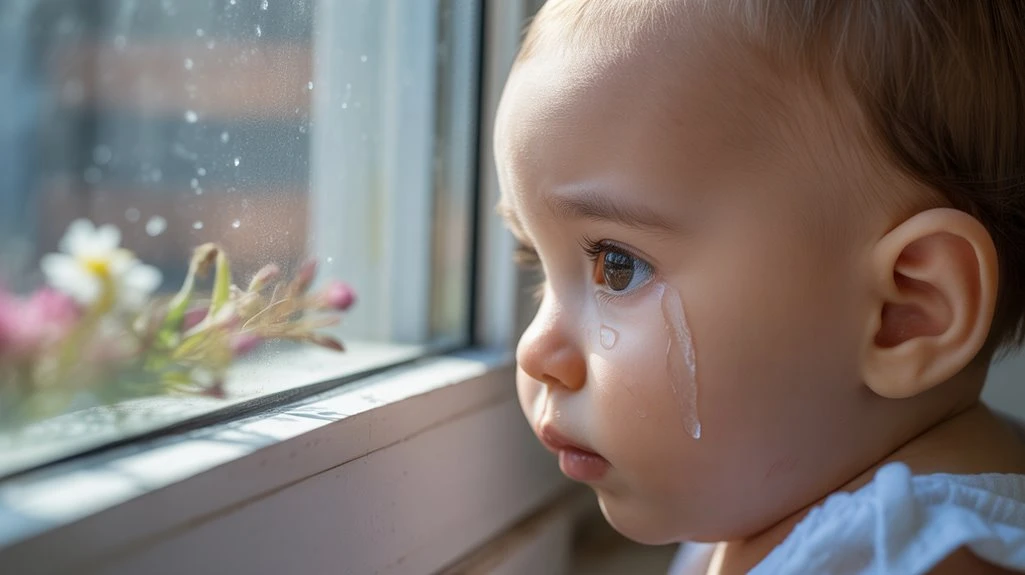
Not all cases of watery eyes in babies stem from infection; allergies and environmental irritants also play a significant role. Your baby’s delicate eyes are sensitive to common allergens like pollen exposure and dust mites. When these particles come into contact with the eyes, the immune system responds by producing extra tears as a protective measure. This reaction can cause persistent tearing, redness, or mild swelling. Babies can’t communicate discomfort, so you need to watch for signs and triggers in their environment. These symptoms can also be linked to underlying eye problems that might require professional evaluation. Here are four emotional situations you might recognize:
- You notice your baby’s eyes watering after playing outside during high pollen seasons.
- Tearfulness increases in rooms with visible dust or pet dander.
- Your baby rubs their eyes frequently at home.
- Symptoms improve when away from certain environments.
When to Seek Medical Advice for Your Baby’s Eyes
Although many cases of watery eyes in babies resolve on their own, certain symptoms warrant prompt medical evaluation. If you notice persistent crusting, redness, swelling, or yellow-green discharge, consult your healthcare provider. These signs may indicate infection or significant tear duct anatomy issues. Viral or bacterial infections can also lead to noticeable changes in eye discharge, including color and consistency, which should be monitored closely. Regular baby eye care includes monitoring for changes that persist beyond a few days or worsen over time.
Here’s a quick reference table for when to seek medical advice:
| Symptom | Duration | Action |
|---|---|---|
| Redness | > 48 hours | See a doctor |
| Swelling | Immediate | Seek urgent care |
| Pus/discharge | Any time | Contact provider |
| Watery eyes only | > 1 week | Get evaluation |
Early intervention guarantees your baby’s vision and eye health are protected.
Powerful Oral Treatment For Watery Eyes- TheraLife
Add To Cart
Frequently Asked Questions
Can Watery Eyes Affect My Baby’S Vision Development?
If your baby has persistent watery eyes, it usually doesn’t cause vision impairment, but it’s important to watch for early signs.
Chronic tearing could occasionally signal underlying issues like blocked tear ducts or infections, which, if untreated, might affect vision development.
You should monitor your baby’s eye health and seek a pediatrician’s advice if symptoms persist.
Early intervention helps guarantee normal vision development and rules out any conditions needing prompt treatment.
Are Certain Babies More Prone to Watery Eyes?
Yes, certain babies are more prone to watery eyes due to specific risk factors.
If your baby is a newborn or younger infant, age differences play a role, as their tear ducts may not be fully developed yet.
Premature babies and those with family histories of tear duct issues face higher risk.
Structural differences, infections, or nasal congestion can also increase your baby’s likelihood of experiencing watery eyes during early development.
Can Teething Cause Watery Eyes in Infants?
You notice your baby’s eyes watering just as those first teeth begin to emerge—could teething symptoms really be to blame?
While teething can cause fussiness, drooling, and mild discomfort, evidence shows it doesn’t directly cause watery eyes.
However, increased drooling or rubbing the face from teething discomfort might lead to eye irritation, which then results in watery eyes.
If symptoms persist, it’s best to consult your pediatrician for proper evaluation.
How Can I Safely Clean My Baby’S Watery Eyes at Home?
When cleaning your baby’s watery eyes at home, always wash your hands first.
Use a clean, damp cotton ball or soft cloth for gentle eye cleaning, wiping from the inner to outer corner. Avoid using the same cloth on both eyes.
Home remedies like saline drops can help, but don’t use any medications without a doctor’s advice.
If discharge is thick, yellow, or persistent, seek medical care to rule out infection.
Do Genetics Play a Role in Blocked Tear Ducts?
Yes, genetics can play a role in blocked tear ducts. You might notice a genetic predisposition if family members have experienced similar issues.
Certain hereditary conditions can affect the development of the tear duct system, making some babies more likely to have blocked ducts.
Clinical studies show that infants with a family history are at higher risk, so it’s important to mention any family occurrences to your pediatrician for appropriate evaluation and care.
Powerful Oral Treatment For Watery Eyes- TheraLife
Add To Cart
Conclusion
If your baby’s eyes appear unusually watery, it’s a common occurrence, with up to 20% of newborns experiencing a blocked tear duct in their first year. While most cases resolve naturally, it’s vital to monitor for redness, swelling, or discharge, which may indicate an infection or other complications. For parents seeking holistic solutions, Theralife offers unique oral eye treatment care, the only company providing such products. Theralife’s offerings are designed to improve and maintain eye health, ensuring your baby’s vision and comfort as they grow. Keep an eye on symptoms and consult healthcare professionals for advice, alongside exploring Theralife’s specialized products for comprehensive eye care.

